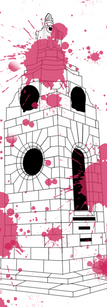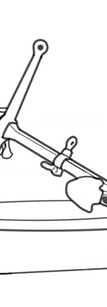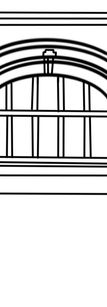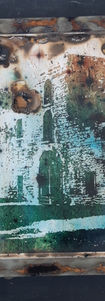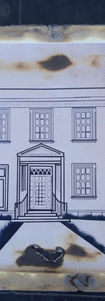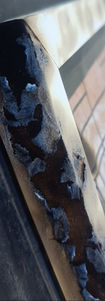top of page
Negotiated learning plan.


My overall theme for this self-negotiated project is to reflect upon my local town that is Workington. I want to replicate my towns local architecture in order to flaunt its beautiful history along with its mesmerizing heritage and traditions. I have a huge passion for art and history so why not combined the two. Im proud of my home town and want to share with people where I grew up.
"There is beauty in ruins, in the history left behind!"
-Ashley-Jay Hunter
My Work
History
Workington is an ancient market and industrial town that is located at the mouth of the Derwent River in Cumbria. Some parts of the town date back to Roman times and although many of its architectural properties my have disappeared through time it still has passed on some of its unique structures and heritage adding new and exciting historical art factors in to todays society. It was in the 18th century, with exploitation of the local iron ore and coal pits, that Workington expanded to become a major industrial town and port sadly the mines/pts are no long in operation and the port itself has drastically lost its trade with in the past 50 years.
Architecture History
There are numerous churches throughout the town, and the parish church of St Michael’s has stood on its present site since the 7th century, although the 12th century Norman church was replaced in 1770 by a larger building. Sadly this was severely damaged by fire in 1994, but has since undergone a major rebuilding program. St John’s Church was built in 1823 to commemorate the battle of Waterloo, to a design by Thomas Hardwick. It is built of local sandstone, and bears some resemblance to Inigo Jones’ St. Paul’s Church in Covent Garden, London.
The Roman Catholic church of Our Lady & St Michael was designed by EW Pugin, and has a very beautiful interior.
The Helena Thompson Museum was bequeathed to the people of Workington by Miss Helena Thompson, a local philanthropist, in 1940. It houses displays of pottery, silver, glass, and furniture dating from Georgian times, as well as the social and industrial history of Workington and the surrounding area.
Workington Hall is built around a pele tower dating from the 14th century, this was once one of the finest Manor houses in the region. This striking ruin once owned by the Curwen family, Lords of the Manor of Workington, gave shelter to Mary Queen of Scots on her last flight from Scotland before her imprisonment and execution.
Jane Pit is a 19th century coal mine built by Henry Curwen, and the remains of this may be seen on a public open space at Mossbay.
Schoose Farm is a model farm, built circa 1800 for John Christian Curwen. There is a windmill, adjoining barns, gatehouse and curtain wall.
Local Tradition.
Uppies and Downies. Its a game which involves the whole town of Workington, the modern tradition began some time in the latter half of the 19th century, with the match played three times a year annually around Easter to raise money for local charities. It is something as a town we all look forward to happening. The object of the game is to "hail the ball" (throw it up in the air three times) at the opposing team's goal. The Downies' goal is a capstan on the Prince of Wales' dock, while the Uppies' is the gates of Workington Hall Parklands. There are no other ostensible rules of play and the game is primarily a rough and tumble scrum interspersed with break-away sprints by members of one team or the other, with some similarities to rugby. Some players from outside Workington take part, especially fellow West Cumbrians from Whitehaven and Maryport, resulting in about a thousand players on each team.
Final Exhibition
In preparation for the studio and show final exhibition me and my fellow art practitioners had to work collectively in order to make it possible, and thanks to our lectures help and guidance we where able to hold a wonderful exhibition which showcased extraordinary talent and potential. Each person was allocated a job role in which we had to complete in order for the exhibition to take place. My job role was Social Media along side Jess Houliston, Milli Marron, Hannah Brown and Mia East. Together we created an Instagram platform which has allowed us to reach a wider audience and display our artwork to the view public who unfortunately weren't able to see in person the work themselves.



The role of Poster Design was dedicated to Bethany Hales, Jude Wareham, Rachel Purvis, Milli Marron and Anna Gallares. They did an amazing job of creating a simplistic yet effective poster of which was posted of the Instagram platform.
For the final gallery I had to make the hard decision of picking which out of my work I created that I would put forward into the final show, although it was a hard decision to come to, the final piece in which I concluded in reflects upon my overall theme for this self negotiated project. The piece I chose is currently untitled. It is roughly 13inch in length, 13 inch in height and 1 inch in width. The work in which I chose is a two piece series in which hold two digital art piece in two individual frames. These digital art piece portray multiple image layered and merged together to depict more than one subject matter at once. These images involved within my work I captured from my local town. The frames in which I have used add depth due to the grey colour chose, this add an extra characteristic to the displayed finally images along with the fact that I have burnt them to alter the aesthetics in order to display a sense of history and a story. This piece has allowed me to display my local town in a beautiful yet un-natural way, taking inspiration from my researched artists (specifically I have adapted to Valerie Hegarty's Style), using both images and rustic styles which contributes to the overall history and story behind the places shown in my work.




bottom of page







































